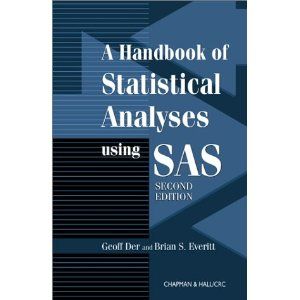A Handbook of Statistical Analyses Using SAS, Second Edition
Publisher: Chapman & Hall; 2 edition (August 21, 2001)
Language: English
ISBN-10: 158488245X
ISBN-13: 978-1584882459
Product Dimensions: 9.1 x 6.1 x 0.8 inches
Shipping Weight: 1.2 pounds
Powerful software often comes, unfortunately, with an overwhelming amount of documentation. As a leading statistics software package, SAS is no exception. Its manuals comprise well over 10,000 pages and can intimidate, or at least bewilder, all but the most experienced users.A Handbook of Statistical Analyses using SAS, Second Edition comes to the rescue. Fully revised to reflect SAS Version 8.1, it gives a concise, straightforward description of how to conduct a range of statistical analyses. The authors have updated and expanded every chapter in this new edition, and have incorporated a significant amount of new material. The book now contains more graphical material, more and better data sets within each chapter, more exercises, and more statistical background for each method. Completely new topics include the following:"Data description and simple inference for categorical variables"Generalized linear models "Longitudinal data: Two new chapters discuss simple approaches, graphs, summary measure, and random effect modelsResearcher or student, new user or veteran, you will welcome this self-contained guide to the latest version of SAS. With its clear examples and numerous exercises, A Handbook of Statistical Analyses using SAS, Second Edition is not only a valuable reference, but also forms the basis for introductory courses on either SAS or applied statistics at any level, from undergraduate to professional.
1 A Brief Introduction to SAS
1.1 Introduction
1.2 The Microsoft Windows User Interface
1.2.1 The Editor Window
1.2.2 The Log and Output Windows
1.2.3 Other Menus
1.3 The SAS Language
公卫考场
1.3.1 All SAS Statements Must End with a Semicolon
1.3.2 Program Steps
1.3.3 Variable Names and Data Set Names
1.3.4 Variable Lists
1.4 The Data Step
1.4.1 Creating SAS Data Sets from Raw Data
1.4.2 The Data Statement
1.4.3 The Infile Statement 公卫家园
1.4.4 The Input Statement
1.4.5 Reading Data from an Existing SAS Data Set
1.4.6 Storing SAS Data Sets on Disk
1.5 Modifying SAS Data
1.5.1 Creating and Modifying Variables
1.5.2 Deleting Variables
1.5.3 Deleting Observations
1.5.4 Subsetting Data Sets 公卫人
1.5.5 Concatenating and Merging Data Sets
1.5.6 Merging Data Sets: Adding Variables
1.5.7 The Operation of the Data Step
1.6 The proc Step
1.6.1 The proc Statement
1.6.2 The var Statement
©2002 CRC Press LLC
1.6.3 The where Statement
1.6.4 The by Statement
1.6.5 The class Statement
1.7 Global Statements
1.8 ODS: The Output Delivery System
1.9 SAS Graphics
1.9.1 Proc gplot
1.9.2 Overlaid Graphs
1.9.3 Viewing and Printing Graphics
1.10 Some Tips for Preventing and Correcting Errors
2 Data Description and Simple Inference: Mortality and Water
Hardness in the U.K.
2.1 Description of Data
2.2 Methods of Analysis
2.3 Analysis Using SAS
Exercises
3 Simple Inference for Categorical Data: From Sandflies to
Organic Particulates in the Air 公卫百科
3.1 Description of Data
3.2 Methods of Analysis
3.3 Analysis Using SAS
3.3.1 Cross-Classifying Raw Data
3.3.2 Sandflies
3.3.3 Acacia Ants
3.3.4 Piston Rings
3.3.5 Oral Contraceptives
3.3.6 Oral Cancers
3.3.7 Particulates and Bronchitis
Exercises
4 Multiple Regression: Determinants of Crime Rate in the
United States
4.1 Description of Data
4.2 The Multiple Regression Model
4.3 Analysis Using SAS
Exercises
5 Analysis of Variance I: Treating Hypertension
5.1 Description of Data 公卫论坛
5.2 Analysis of Variance Model
5.3 Analysis Using SAS
©2002 CRC Press LLC
Exercises
6 Analysis of Variance II: School Attendance Amongst
Australian Children
6.1 Description of Data
6.2 Analysis of Variance Model
6.2.1 Type I Sums of Squares
6.2.2 Type III Sums of Squares
6.3 Analysis Using SAS
Exercises
7 Analysis of Variance of Repeated Measures: Visual Acuity
7.1 Description of Data
7.2 Repeated Measures Data
7.3 Analysis of Variance for Repeated Measures Designs 公卫人
7.4 Analysis Using SAS
Exercises
8 Logistic Regression: Psychiatric Screening, Plasma Proteins, and
Danish Do-It-Yourself
8.1 Description of Data
8.2 The Logistic Regression Model
8.3 Analysis Using SAS
8.3.1 GHQ Data
8.3.2 ESR and Plasma Levels 公卫百科
8.3.3 Danish Do-It-Yourself
Exercises
9 Generalised Linear Models: School Attendance Amongst
Australian School Children
9.1 Description of Data
9.2 Generalised Linear Models
9.2.1 Model Selection and Measure of Fit
9.3 Analysis Using SAS
公卫百科
Exercises
10 Longitudinal Data I: The Treatment of Postnatal Depression
10.1 Description of Data
10.2 The Analyses of Longitudinal Data
10.3 Analysis Using SAS
10.3.1 Graphical Displays
10.3.2 Response Feature Analysis
Exercises 公卫家园
©2002 CRC Press LLC
11 Longitudinal Data II: The Treatment of Alzheimer’s Disease
11.1 Description of Data
11.2 Random Effects Models
11.3 Analysis Using SAS
Exercises
12 Survival Analysis: Gastric Cancer and Methadone Treatment
公卫人
of Heroin Addicts
12.1 Description of Data
12.2 Describing Survival and Cox’s Regression Model
12.2.1 Survival Function
12.2.2 Hazard Function
12.2.3 Cox’s Regression
12.3 Analysis Using SAS
12.3.1 Gastric Cancer
12.3.2 Methadone Treatment of Heroin Addicts 公卫考场
Exercises
13 Principal Components Analysis and Factor Analysis:
The Olympic Decathlon and Statements about Pain
13.1 Description of Data
13.2 Principal Components and Factor Analyses
13.2.1 Principal Components Analysis
13.2.2 Factor Analysis 公卫家园
13.2.3 Factor Analysis and Principal Components
Compared
13.3 Analysis Using SAS
13.3.1 Olympic Decathlon
13.3.2 Statements about Pain
Exercises
14 Cluster Analysis: Air Pollution in the U.S.A.
14.1 Description of Data
14.2 Cluster Analysis 公卫考场
14.3 Analysis Using SAS
Exercises
15 Discriminant Function Analysis: Classifying Tibetan Skulls
15.1 Description of Data
15.2 Discriminant Function Analysis
15.3 Analysis Using SAS
Exercises
©2002 CRC Press LLC
16 Correspondence Analysis: Smoking and Motherhood, 公卫论坛
Sex and the Single Girl, and European Stereotypes
16.1 Description of Data
16.2 Displaying Contingency Table Data Graphically Using
Correspondence Analysis
16.3 Analysis Using SAS
16.3.1 Boyfriends
16.3.2 Smoking and Motherhood
16.3.3 Are the Germans Really Arrogant? 公卫论坛
Exercises
Appendix A: SAS Macro to Produce Scatterplot Matrices
Appendix B: Answers to Selected Chapter Exercises
References
附件列表
您所在的用户组无法下载或查看附件
词条内容仅供参考,如果您需要解决具体问题
(尤其在法律、医学等领域),建议您咨询相关领域专业人士。
如果您认为本词条还有待完善,请 编辑
上一篇 Common Statistical Methods for Clinical Research with SAS Examples, 2nd Edition 下一篇 李志华


